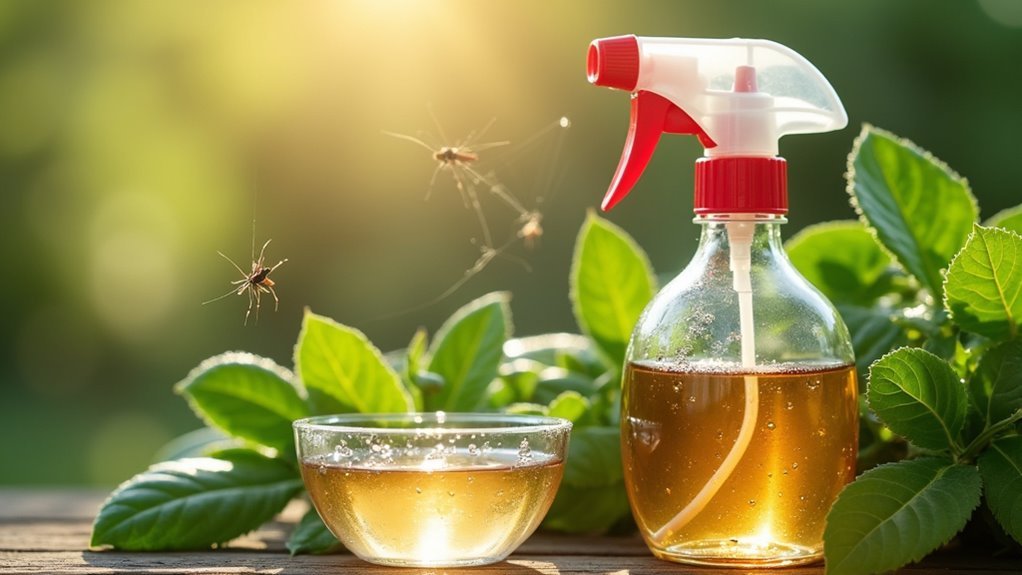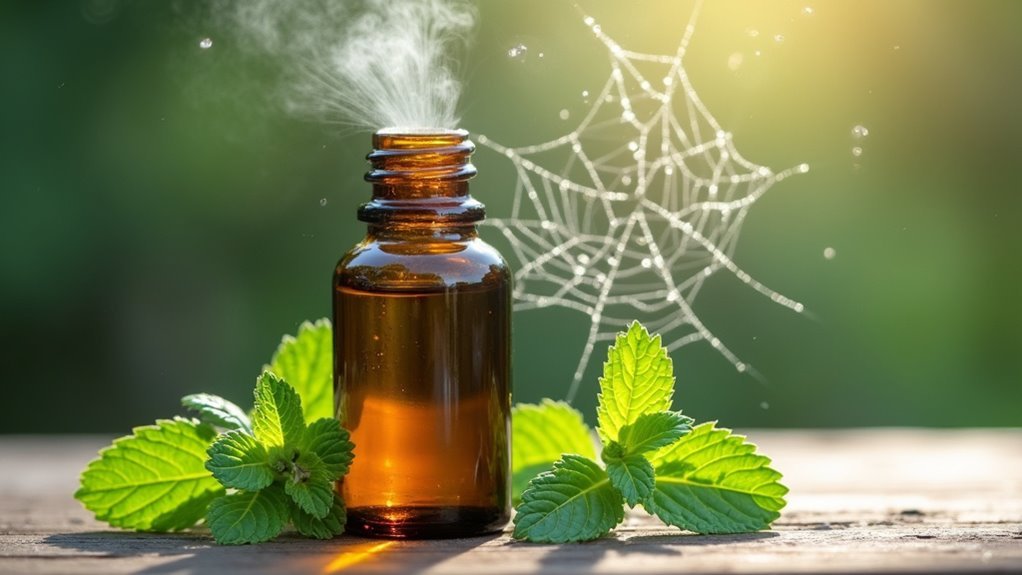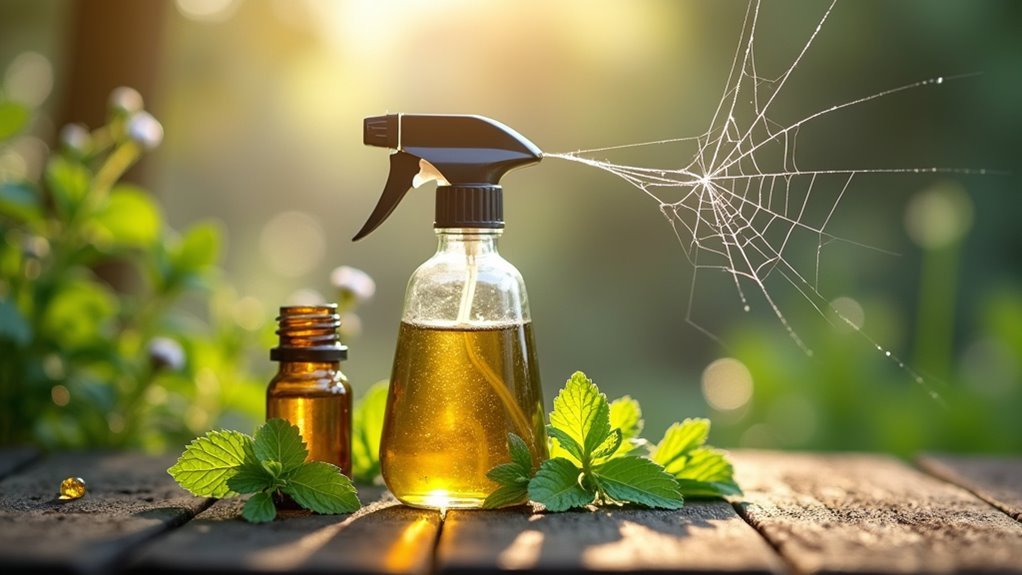You can make an effective spider repellent in minutes using ingredients you already have at home. Mix 2 cups of white vinegar with 1/4 cup of liquid dish soap in a 16-ounce spray bottle, then add 30 drops of peppermint or cinnamon essential oil. Shake thoroughly and spray directly on spiders, webs, and entry points like windowsills and door frames. This natural solution is safer for children and pets than chemical alternatives, and proper application techniques will maximize your spider-fighting success.
Why Choose Homemade Spider Repellent Over Store-Bought Options

When you’re dealing with unwanted eight-legged visitors, homemade spider repellents offer significant advantages over their commercial counterparts.
You’ll find that natural ingredients like vinegar, essential oils, and soap create safer solutions for homes with children and pets. Unlike chemical-heavy store products, your DIY Spider Spray can be customized to target specific spider species while remaining environmentally friendly and non-toxic.
Cost-effectiveness makes homemade repellents particularly appealing since you’re using common household items. You can prepare these solutions quickly and easily whenever needed.
Essential Ingredients You Already Have at Home
The best part about creating your own spider repellent is that you don’t need to make a special shopping trip. Your kitchen pantry likely contains everything needed for effective homemade sprays.
White vinegar serves as your base ingredient, creating a powerful natural spider repellent when mixed with water and dish soap that kills spiders instantly.
White vinegar mixed with water and dish soap creates an instant-acting natural spider repellent using common household ingredients.
Peppermint oil from your spice cabinet disrupts spiders’ environmental sensors when diluted properly. Cinnamon essential oil enhances vinegar-based solutions with its potent aroma.
Even garlic can be blended into water and soap for a strong deterrent mixture. Don’t overlook fresh basil either – this common herb naturally repels spiders whether grown indoors or outdoors.
Simple Vinegar and Water Spider Spray Recipe

You’ll need just white vinegar and water in equal parts to create an effective spider spray that kills on contact.
Mix these ingredients in a spray bottle, then add one tablespoon of dish soap for every two cups of mixture to help it stick to spiders and disrupt their reproductive cycles.
Apply this non-toxic solution directly on spiders and webs, reapplying every few days for best results in high-activity areas.
Basic Vinegar Spray Recipe
Since spiders dislike acidic environments, creating a basic vinegar spray offers one of the simplest and most cost-effective methods for repelling these unwanted visitors from your home.
This homemade repellent requires only distilled white vinegar and water, making it accessible to anyone looking for an immediate spider control solution.
To create your vinegar spray, you’ll need these essential components and steps:
- Mix equal parts distilled white vinegar and water in a spray bottle
- Add one tablespoon of liquid dish soap per two cups of mixture for better adherence
- Apply directly on spiders or in areas where they typically hide
- Reapply frequently for maximum effectiveness against spider entry and web formation
- Store in a cool, dark place and shake well before each use
This spray kills spiders on contact while deterring future infestations.
Application and Effectiveness Tips
Proper application techniques can greatly boost your vinegar spray’s spider-fighting power beyond the basic recipe.
Target spiders directly and saturate their webs completely for maximum impact. Focus on entry points like windowsills, door frames, and cracks where spiders typically enter your home. The vinegar’s strong scent creates an effective spider deterrent barrier when applied consistently.
For enhanced results with your DIY spider spray, add a few drops of peppermint oil to amplify the repelling properties. This combination creates a more potent natural solution that spiders actively avoid.
Reapply every few days or immediately after cleaning to maintain effectiveness.
Don’t forget basement corners, garage edges, and outdoor patios where spiders commonly nest. Consistency is key for long-term spider control success.
Adding Dish Soap for Maximum Effectiveness
While basic homemade spider repellents can deter these pests, adding dish soap transforms your mixture into a more potent weapon against spiders.
The surfactant properties in dish soap help your DIY spider solution adhere directly to spiders and penetrate their protective outer layer, causing dehydration and death upon contact.
When incorporating dish soap with essential oils, use one tablespoon per two cups of liquid for maximum effectiveness.
This ratio guarantees your repellent can:
- Break down spider webs and penetrate egg sacs more effectively
- Create uniform distribution of essential oils throughout the mixture
- Disrupt spiders’ protective coating leading to elimination
- Enhance adhesion to surfaces for longer-lasting protection
- Improve contact time between repellent and target pests
Always test on small areas first to prevent potential staining.
Peppermint Oil Spider Deterrent Formula

You’ll need to mix 5 to 10 drops of peppermint oil with 2 cups of water and one tablespoon of dish soap in a glass spray bottle for your spider deterrent.
Apply this mixture around spider-prone areas like doors, windows, and room corners where spiders typically enter or hide.
Test the spray on a small surface first, then reapply monthly to maintain its effectiveness as the peppermint scent naturally repels spiders from treated areas.
Essential Oil Mixing
When creating an effective peppermint oil spider deterrent, you’ll need to combine 5 to 10 drops of peppermint oil with 2 cups of water in a glass spray bottle. This homemade spider spray uses peppermint essential oil’s natural properties to repel spiders effectively.
- Use only glass spray bottles to prevent essential oil degradation from plastic containers.
- Add one tablespoon of dish soap to help the solution stick to treated surfaces.
- Start with 5 drops for mild infestations and increase to 10 drops for heavy spider activity.
- Shake the bottle vigorously before each use to guarantee proper mixing.
- Test the mixture on a small, inconspicuous area first to check for surface compatibility.
This simple mixing process creates a powerful natural deterrent that’s both cost-effective and environmentally friendly.
Application and Coverage
Target three key areas when applying your peppermint oil spider deterrent: entry points, hiding spots, and travel routes. Focus your spray application on corners where walls meet, windowsills, doorways, and baseboards where spiders typically establish residence.
These locations offer the perfect combination of shelter and access to prey.
Before full application, test your peppermint oil mixture on a small, hidden area to check for potential staining or surface damage. Once confirmed safe, spray generously in target zones, guaranteeing complete coverage of suspected spider habitats.
Reapply your deterrent monthly to maintain its repelling power. Natural peppermint oil loses potency over time, so consistent reapplication guarantees continued effectiveness.
Store your spray in a glass bottle rather than plastic to prevent degradation and maintain the solution’s strength.
Cinnamon Essential Oil Spray for Killing Spiders
Since cinnamon essential oil disrupts spiders’ ability to detect food and navigate through its potent scent, it’s become one of the most effective natural solutions for both repelling and killing these unwanted visitors.
This powerful spider infestation remedy works by overwhelming their sensory systems, making your home uninhabitable for them.
Creating your cinnamon spray is straightforward and highly effective:
- Mix 30 drops of cinnamon essential oil with 2 cups distilled white vinegar
- Add 1/4 cup liquid soap to the mixture
- Combine everything in a 16-ounce glass spray bottle
- Apply to corners, windowsills, and doorways where spiders hide
- Reapply weekly during peak spider seasons for maximum effectiveness
This combination doesn’t just repel spiders—it eliminates spider egg sacs, making it exceptionally potent against infestations.
How to Prepare Your DIY Spider Repellent
Although store-bought spider sprays contain harsh chemicals, you can create an equally effective repellent using simple household ingredients.
Start with a 16-ounce glass spray bottle and add 2 cups of distilled white vinegar, which acts as a natural insecticide.
Mix in 1/4 cup of liquid soap, such as castile or dish soap, to help the solution adhere to spiders and enhance effectiveness.
Incorporate 30 drops of cinnamon essential oil into the mixture, as it’s known to repel spiders and disrupt their egg cycles.
Secure the spray nozzle tightly and shake for 20 seconds to guarantee all ingredients combine well.
Your DIY spider repellent is ready for immediate use.
Best Application Techniques for Maximum Results
Creating your spider repellent is only half the battle—proper application determines how well it works. You’ll need strategic application techniques to maximize your homemade sprays’ effectiveness against these unwanted visitors.
Success with spider repellent isn’t just about the recipe—it’s about applying it strategically where spiders actually live and enter your home.
Target spider hotspots like cobwebs, window sills, and door frames where spiders typically build webs and enter your home. Test your spray on inconspicuous areas first to prevent surface damage or staining.
- Apply spider repellent directly on cobwebs, window sills, and door frames
- Use a 1:1 water-to-vinegar ratio for contact-killing effectiveness
- Reapply weekly during peak spider seasons for continuous protection
- Test on small, hidden areas before full surface application
- Combine ultrasonic devices with sprays for enhanced deterrent effects
Consistent reapplication every week maintains your protective barrier against new spider arrivals.
Where to Spray for Optimal Spider Control
You’ll achieve the best results by targeting specific indoor areas where spiders commonly hide and establish their webs.
Focus your spray application on entry points, dark corners, and secluded spaces throughout your home’s interior.
Don’t forget to treat key outdoor zones around your property’s perimeter to create a thorough barrier against spider invasion.
Indoor Target Areas
Five strategic locations inside your home require immediate attention when applying spider repellent for maximum effectiveness.
These indoor target areas represent the most critical zones where spiders establish their territories and build webs.
Focus your spider repellents on these key locations:
- Corners and crevices – Check behind furniture and in tight spaces where spiders commonly nest
- Windows and door frames – Create protective barriers at entry points from outside
- Basements and attics – Target these dark, undisturbed areas where spiders thrive
- Baseboards and under sinks – Address moisture-rich zones that attract both spiders and their prey
- Hidden spaces behind appliances – Don’t overlook areas where webs can develop unnoticed
Thorough coverage of these zones guarantees extensive indoor spider control.
Outdoor Application Zones
Strategic outdoor application creates the most effective first line of defense against spider invasions before they reach your home’s interior.
Focus your repellent application around entry points like doors, windows, and vents where spiders commonly attempt access. Apply the solution along your home’s foundation and fill any cracks or crevices to establish a protective barrier.
Target web-building locations including under eaves, along fences, and in patio or deck corners.
Don’t overlook outdoor lighting fixtures, as they attract insects that draw spiders seeking food sources. Create a thorough perimeter by treating these strategic zones systematically.
Reapply your repellent every few weeks or after heavy rainfall, since moisture washes away the protective barrier and reduces effectiveness against spiders.
How Often to Reapply Your Homemade Solution
How frequently should you reapply your homemade spider repellent to keep those eight-legged intruders at bay?
Generally, you’ll need to reapply your homemade solution every 1-2 weeks to maintain its effectiveness and keep spiders away, especially during peak seasons in spring and fall.
Essential oil-based solutions lose potency faster and require weekly applications. Rain and heavy cleaning can wash away your repellent’s effectiveness, so reapply immediately after these events.
- Apply vinegar-based sprays directly on cobwebs weekly to disrupt spider habitats
- Increase frequency to every few days in high-activity areas like basements and attics
- Reapply essential oil solutions weekly due to diminishing potency
- Target peak spider seasons (spring and fall) with consistent 1-2 week intervals
- Always reapply after rain or significant environmental changes
Safety Considerations When Using Natural Repellents
While natural spider repellents are generally safer than chemical alternatives, you’ll still need to take important precautions to protect your family and pets.
Essential oils and plant-based ingredients can pose risks if ingested or mishandled, making proper storage and application vital for household safety.
You should also consider that some natural ingredients like mint can be toxic to cats and dogs, requiring careful research before use.
Pet and Child Safety
Safety becomes paramount when implementing natural spider repellents in homes with children and pets. Many essential oils in homemade spider sprays can be toxic to cats and dogs, making pet safety a critical consideration.
You’ll need to apply these natural repellents when children and pets aren’t present to minimize harmful exposure.
Essential precautions for safe use:
- Keep peppermint and cinnamon oils completely out of pets’ reach
- Consult your veterinarian before using any specific natural repellents around animals
- Monitor pets around repellent plants like mint or lavender that could cause issues if ingested
- Apply homemade sprays only when the area is unoccupied by children and pets
- Regularly assess both effectiveness and safety of your chosen repellent methods
Individual pet sensitivities vary greatly, requiring ongoing vigilance.
Application and Storage Precautions
Even with natural ingredients, proper application and storage protocols protect your household from unintended consequences.
Store homemade repellents in secure locations away from children and pets to prevent accidental ingestion. Remove kids and animals from treated areas during application to avoid irritation or adverse reactions.
Before widespread use, conduct patch tests on small surfaces since some mixtures may stain or damage materials.
Reapply your repellent regularly as effectiveness decreases over time, particularly after cleaning or moisture exposure.
Choose pet-friendly alternatives when necessary, as certain ingredients like peppermint oil can be toxic to animals.
Always read ingredient safety information and select formulations appropriate for your household’s specific needs to maintain both effectiveness and safety.
Additional Natural Spider Prevention Methods
Beyond using scented deterrents, you’ll find that consistent home maintenance plays a crucial role in keeping spiders at bay.
These natural prevention methods create an unwelcoming environment that’ll discourage spiders from establishing residency in your space.
- Vacuum thoroughly and regularly – Focus on corners, under furniture, and behind appliances to remove webs and disrupt spider habitats.
- Plant spider-repellent herbs – Position basil, lavender, and mint around doorways and windows for natural deterring spiders while beautifying your home.
- Store firewood away from house – Keep wood piles distant to avoid attracting spiders and other pests.
- Seal entry points – Use caulking or weather stripping around doors, windows, and foundation cracks.
- Control humidity levels – Run dehumidifiers and promote proper ventilation to create less favorable conditions.
Testing Your Spray Before Full Application
Before you spray your entire home with your homemade spider deterrent, you’ll want to test it on a small, hidden area first. This patch test prevents potential staining or adverse reactions on your surfaces.
Choose an inconspicuous spot and spray a small amount, then wait 24 hours to check for damage or discoloration.
If you’re using essential oils in your mixture, make sure they’re properly diluted to avoid irritating pets or children.
Start testing in a low-traffic room to gauge effectiveness without disrupting your daily routine.
Document your results carefully, noting any immediate changes in spider activity and surface reactions.
This documentation helps you refine your formula if needed, making certain your final spray works effectively while protecting your home’s surfaces and occupants.
Storing Your Homemade Spider Repellent Properly
Once you’ve perfected your spider repellent formula, proper storage becomes crucial for maintaining its effectiveness.
Proper storage is the key to keeping your homemade spider repellent effective and maintaining its natural ingredient potency over time.
You’ll want to store your homemade mixture correctly to preserve the potency of natural ingredients like essential oils and vinegar.
- Use a glass spray bottle instead of plastic, which can degrade and leach chemicals into your mixture over time.
- Store in a cool, dark place away from direct sunlight and heat sources.
- Label your bottle with preparation date and ingredients to track freshness and effectiveness.
- Keep the repellent out of reach of children and pets for safety reasons.
- Recheck the mixture every few weeks for changes in odor or appearance, discarding if spoiled.
Following these storage guidelines guarantees your spider repellent remains potent and safe for continued use.
Frequently Asked Questions
What Is the Best Homemade Spider Repellent?
You’ll get excellent results mixing 2 cups distilled white vinegar, 1/4 cup liquid soap, and 30 drops cinnamon essential oil. This combination repels and kills spiders while staying safe for kids and pets.
What Scent Will Keep Spiders Away?
You’ll find that peppermint, cinnamon, and lavender essential oils effectively repel spiders by disrupting their food detection abilities. Vinegar’s strong scent also works well, making these natural options perfect for keeping spiders away.
How Do You Make Homemade Spider Pest Control?
You can make homemade spider pest control by mixing equal parts white vinegar and water with dish soap, or combining peppermint oil with water and soap in a spray bottle.
What Repels Spiders the Most?
You’ll find peppermint oil repels spiders most effectively since they’re extremely sensitive to its strong scent. Vinegar also works powerfully, killing spiders on contact while disrupting their reproduction cycles completely.
In Summary
You’ve got everything you need to create effective spider repellent right in your kitchen. Start with the basic vinegar spray, then experiment with peppermint oil for added power. Remember to test your mixture first and store it properly for best results. With these simple ingredients and recipes, you’ll keep spiders away naturally while saving money and avoiding harsh chemicals. Your homemade solution works just as well as expensive store-bought alternatives.





Leave a Reply